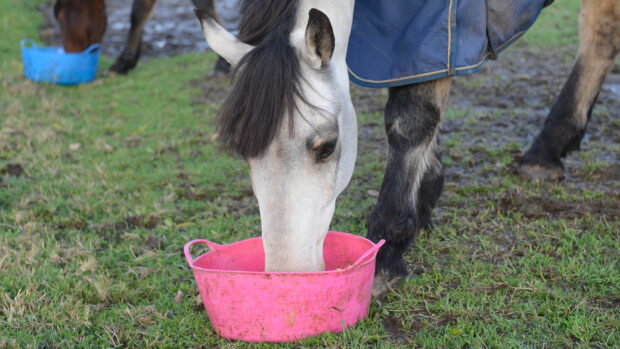Conor is a 15hh 10-year-old Irish/Arab who is currently receiving 40-60min exercise daily (walk, trot and canter) to get fit for hunting. Over the winter he will be hunting at least once a week, and being exercised to maintain his fitness in between. He has no health problems.
He is currently fed half a scoop chaff and one scoop of leisure mix (Dodson & Horrell) with salt each evening with ad-lib HorseHage. He is stabled during the day and turned out over night.
Once the winter arrives his feed will be adjusted to one scoop each of chaff, leisure mix, and Baileys No 4 top line nuts plus half a scoop sugar beet. He will also be fed salt, garlic and vegetable oil. This will form one evening feed. His turnout will be restricted, depending on the condition of the turnout paddocks, which are clay-based.
Dr Frape’s assessment
When hunting starts Conor is likely to need 2kg more hard feed than is planned for in the winter. If feed capacity – the amount of feed he is physically able to consume – is limiting then perhaps the oil allowance should be increased to 0.5litres per day. The haylage intake is likely to decrease somewhat.
His feeds should also be split into at least two per day. If only one hard feed per day is possible for management reasons, then feeding something like Gastric Settler (Hickstead Horse Feeds) as the feed allowance is increased should reduce the risk of colic, gastric ulceration and so on.
If a horse is to receive a large single meal of hard feed, rich in starch, there is an increased risk of disruption to normal gastric digestion. This is caused by stomach bacteria that ferment the feed, leading to an increased risk of colic, erosion of the stomach wall and other ailments. Gastric Settler reduces that risk by, among other things, moderating the population shift in bacteria, absorbing toxins.
Top tips
The best guide for assessing the adequacy of a horse’s feed regime is to look at the changes in its weight and skin fold thickness over time. Girth should ideally be measured at the same time of day to ensure consistency.
Where a horse is losing condition, the daily allowance of feed and pasture quality should be checked in relation to workload.
Any increase in feed allowance should be gradual, and for horses in a fit condition, it should occur as work rate increases, not before.
Haylage is an excellent roughage for working horses and is a good source of calcium, but it tends to be lacking in vitamin E.
Where the feed allowance is to be increased as harder training and work are commenced, then it is preferable that additional hard feed is given as an additional meal.
Knowledge of one’s own horse and surroundings is particularly important and it would be wrong to assert that an individual horse requires more or less, based solely upon written data, particularly given the variability in the nutritive value of hays and pastures.
|
||
 |
||


 Get up to 19 issues FREE
Get up to 19 issues FREE TO SUBSCRIBE
TO SUBSCRIBE 


